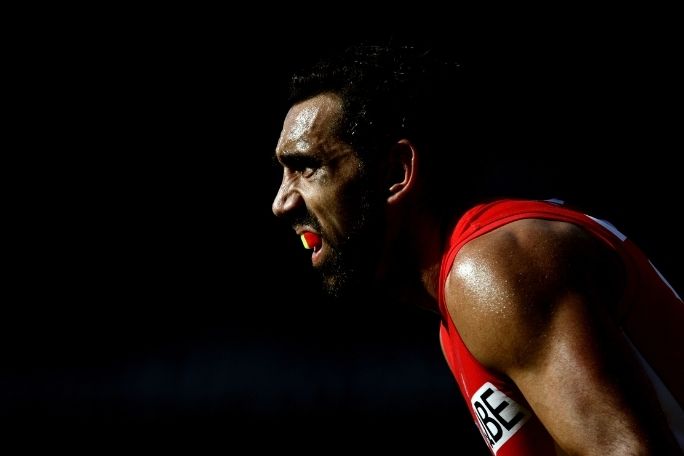Lesson summary
Retired AFL star Adam Goodes is known to many for his resilient journey in the face of detrimental treatment by AFL spectators and the media beginning in 2013.
This lesson focuses on the continued booing of Adam Goodes during 2015. Students view clips from The Final Quarter and critically evaluate some of the diverse perspectives that were present in the media at the time. Students consider the different types of racism and unpack myths and subtleties of racism, linking these concepts back to the booing of Adam Goodes. Through a role-play, students develop a proposal for how the AFL might have resolved the booing.
Learning intentions:
Students will...
- understand that there are different types of racism, and all of them are harmful
- understand that racism isn’t always obvious to everyone, but that doesn’t mean it doesn’t have an impact
- understand that commercial media is powerful and is in a position to persuade vast numbers of people to believe in a particular perspective
- understand the responsibility of sports organisations, such as the AFL, to care for its players and make a stand against racism.
Success criteria:
Students can...
- analyse the issue of booing in sport from various perspectives
- evaluate the role of the supporters in establishing atmosphere and safety for each other and the players
- identify the implications of booing of an individual player, including harm caused by bullying and racism.
Lesson guides and printables
Curriculum links
Select your curriculum from the options below.
Lesson details
Curriculum mapping
Australian Curriculum content descriptions:
Year 9 & 10 Health and Physical Education:
- Evaluate factors that shape identities and critically analyse how individuals impact the identities of others (ACPPS089)
- Investigate how empathy and ethical decision making contribute to respectful relationships (ACPPS093)
- Evaluate situations and propose appropriate emotional responses and then reflect on possible outcomes of different responses (ACPPS094)
- Critique behaviours and contextual factors that influence health and wellbeing of diverse communities (ACCPPS098)
Syllabus outcomes: PDHPE5.1, PDHPE5.3, DHPE5.11, PDHPE5.13, PDHPE5.16
General capabilities: Literacy, Critical and Creative Thinking, Personal and Social Capability, Ethical Understanding, Intercultural Understanding
Cross-curriculum priority: Aboriginal and Torres Strait Islander History and Cultures (OI.6, OI.9)
Relevant parts of Year 9 & 10 achievement standards:
By the end of Year 10, students critically analyse contextual factors that influence identities, relationships, decisions and behaviours. They analyse the impact attitudes and beliefs about diversity have on community connection and wellbeing. They evaluate the outcomes of emotional responses to different situations. Students access, synthesise and apply health information from credible sources to propose and justify responses to health situations.
They apply decision-making and problem-solving skills when taking action to enhance their own and others’ health, safety and wellbeing.
This lesson is part of the wider unit of work The Final Quarter – Racism in Sport – Years 9 & 10
Time required: 65 mins
Level of teacher scaffolding: High – facilitate class discussion with sensitivity to students’ feelings and experience (in relation to racial discrimination).
Resources required
- Device capable of presenting a video to the class
- Media Articles – 3-5 copies to distribute between groups
- UN General Assembly Article – three copies
- Soft football or other soft ball
- Student Worksheets – one copy per student
- Different Forms Of Racism (optional)
- Handling Sensitive Topics and Issues (optional)
- Racism Vocabulary (optional)
Skills
This lesson is designed to build students’ competencies in the following skills:
- Collaboration
- Communication
- Community engagement
- Critical thinking
- Cultural understanding
- Empathy
- Ethical understanding
- Problem solving
Additional info
Using only archival footage aired at the time, The Final Quarter holds a mirror to Australia and is an opportunity to reconsider what happened on and off the football field. Learn more about the film here.
We highly recommend that students view the film in its entirety before participating in subsequent lessons.
Our Watching the Film lessons are designed to support you in facilitating this process. Given the content, it is also important for teachers to communicate with parents and guardians of Aboriginal and Torres Strait Islander students before playing the film and/or engaging with the teaching and learning resources.
Note: This film may not be suitable for viewing by all young people. Teachers are advised to use their discretion when deciding whether to show this film. If teaching in a context with a high proportion of Aboriginal and Torres Strait Islander children, it is imperative that guidance is sought from the Principal and Aboriginal Education Officer (or equivalent) prior to screening the film.


Welcome back!
Don't have an account yet?
Log in with:
Create your free Cool.org account.
Many of our resources are free, with an option to upgrade to Cool+ for premium content.
Already have an account?
Sign up with:
By signing up you accept Cool.org's Terms and Conditions(Opens in new tab) and Privacy Policy(Opens in new tab).